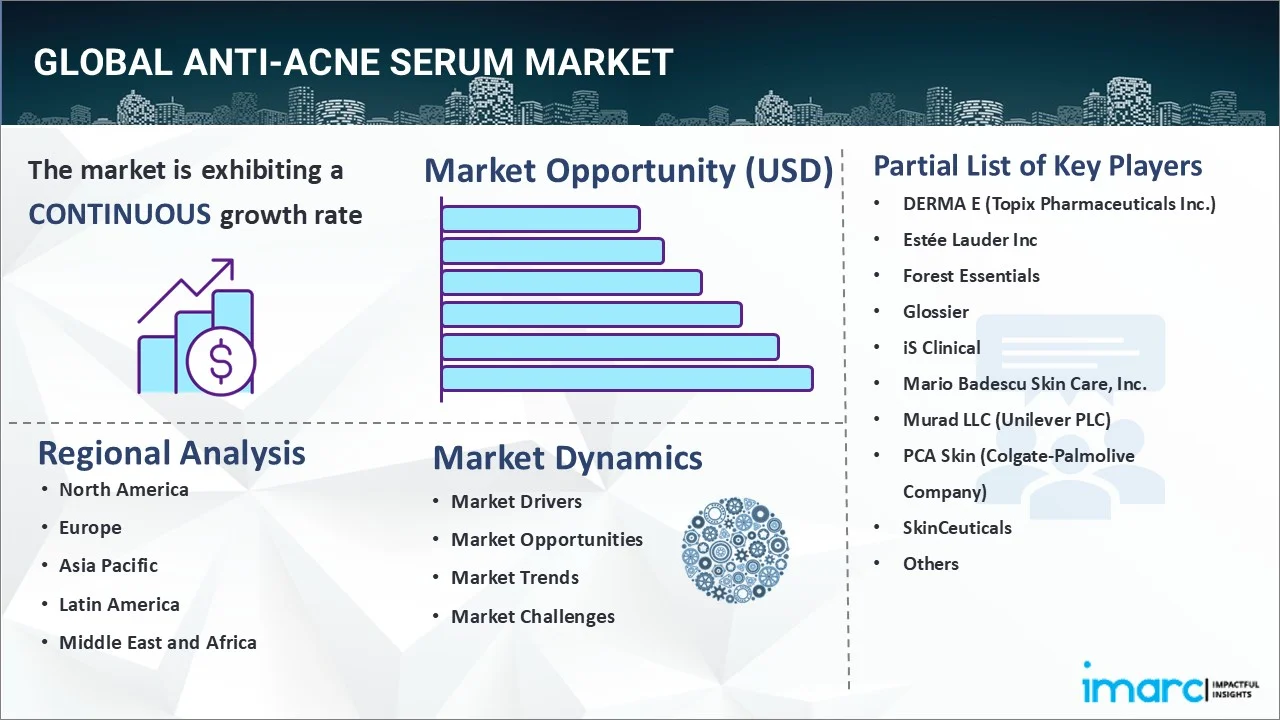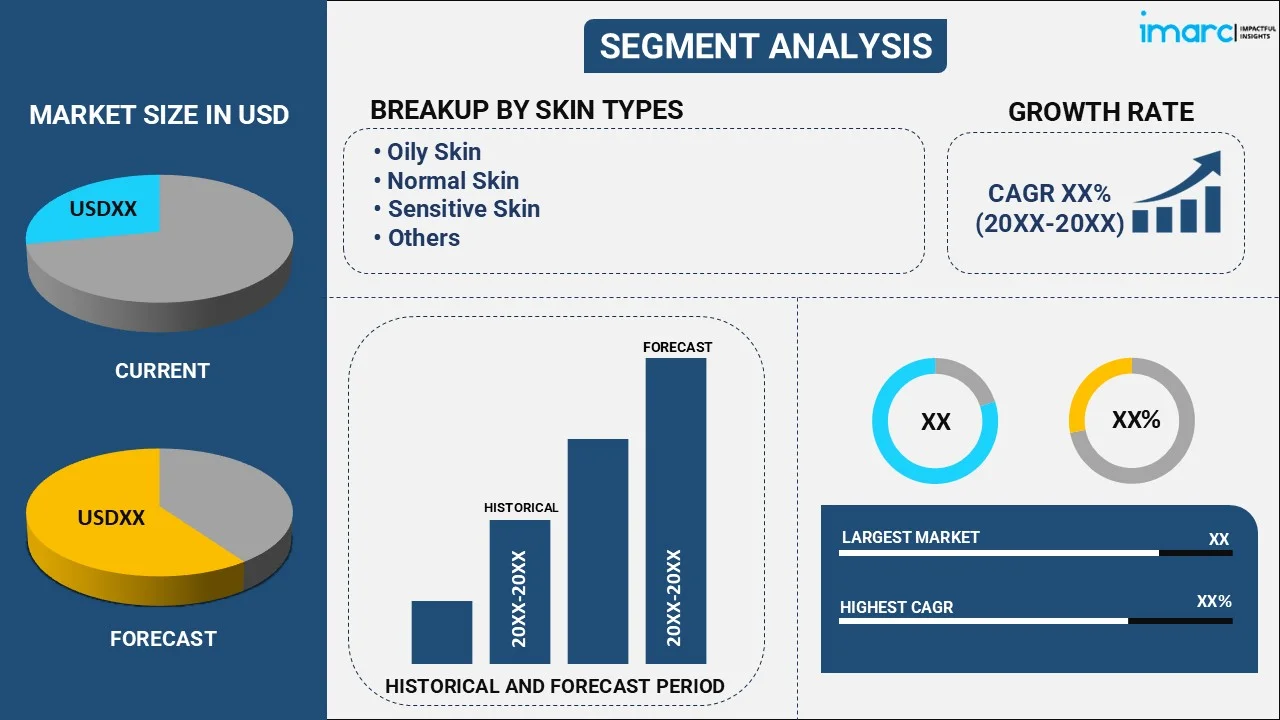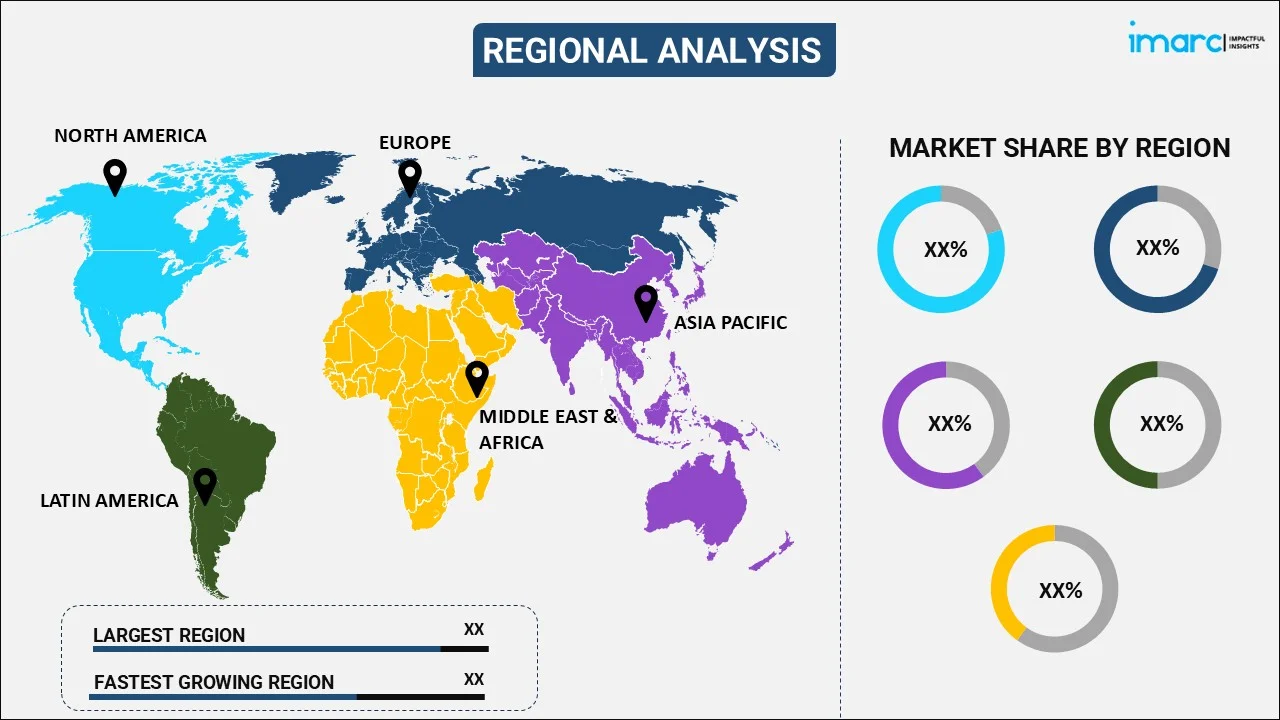
Anti-Acne Serum Market Report by Skin Type (Oily Skin, Normal Skin, Sensitive Skin, Dry Skin, Combination Skin), Ingredients Type (Organic, Natural, Synthetic), Distribution Channel (Supermarkets and Hypermarkets, Specialty Stores, Pharmacy and Drug Stores, Online Stores, and Others), End User (Men, Women), and Region 2025-2033
Global Anti-Acne Serum Market:
The global anti-acne serum market size reached USD 1,311.8 Million in 2024. Looking forward, IMARC Group expects the market to reach USD 2,174.6 Million by 2033, exhibiting a growth rate (CAGR) of 5.72% during 2025-2033. The increasing prevalence of acne, the rising consumer awareness and consciousness about skincare, advancements in skin formulation, demand for organic products, and social media influence are some of the key factors primarily driving the market growth.
|
Report Attribute
|
Key Statistics
|
|---|---|
|
Base Year
|
2024
|
|
Forecast Years
|
2025-2033
|
|
Historical Years
|
2019-2024
|
|
Market Size in 2024
|
USD 1,311.8 Million |
|
Market Forecast in 2033
|
USD 2,174.6 Million |
| Market Growth Rate 2025-2033 | 5.72% |
Anti-Acne Serum Market Analysis:
- Major Market Drivers: The increasing concerns among individuals about their physical appearance and rising awareness about skin-related issues like acne and pigmentation are primarily bolstering the market growth. In addition, the growing demand for premium quality anti-acne serum on account of rapid urbanization and the expanding purchasing power of consumers is also driving the market.
- Key Market Trends: The emerging trend of online shopping on account of the easy availability, vast catalog, convenience offered, fast shipping facilities with innumerable discounts, cashback, and offers, along with the burgeoning e-commerce industry, is expected to proliferate the industry demand. Moreover, the escalating demand for gifting unique items, such as anti-acne serums with other skin essentials in innovative packaging and boxes, is also escalating the market growth.
- Competitive Landscape: Some of the prominent companies in the market include DERMA E (Topix Pharmaceuticals Inc.), Estée Lauder Inc, Forest Essentials, Glossier, iS Clinical, Mario Badescu Skin Care, Inc., Murad LLC (Unilever PLC), PCA Skin (Colgate-Palmolive Company), SkinCeuticals, Sunday Riley, and Ulta Beauty Inc., among many others.
- Geographical Trends: Europe is dominating the overall market. There is a rising awareness among consumers in Europe regarding skincare and the treatment of acne. More individuals are seeking effective solutions to manage acne and improve skin health, driving the demand for specialized products like anti-acne serums.
- Challenges and Opportunities: High competition among key players, sensitive skin concerns, and regulatory compliances are some of the challenges that the market is facing. However, continuous innovation in skincare technology and ingredient science presents opportunities to develop more effective anti-acne formulations. Advances in microencapsulation, delivery systems, and natural extracts offer new possibilities.

Anti-Acne Serum Market Trends:
Rising Prevalence of Acne
The rising prevalence of acne is a significant factor driving the demand for anti-acne products, including serums. Acne is a common skin condition that affects individuals of all ages, but it is particularly prevalent among adolescents and young adults. For instance, according to an article published by MDacne in November 2023, acne affects almost half of women in their twenties, 33% in their thirties, and 25% in their forties. Moreover, modern lifestyles characterized by stress, poor diet, lack of sleep, and inadequate skincare routines can contribute to the development or exacerbation of acne. For instance, according to an article published by Healthline, frequent eating of meals heavy in fat or sugar was linked to an 18% increased risk of acne, while sugary beverages were linked to a 54% increased risk. Besides this, high-glycemic index foods and dairy products have been associated with exacerbating acne. For instance, according to an article published by Curology, foods with a high glycemic index have a quick blood sugar increase that makes the body create more insulin, a hormone that tells the body how to use or store the sugar in your blood. High blood sugar can cause acne and widespread inflammation. These factors are further contributing to the anti-acne serum market share.
Growing Number of Product Launches
The rising number of product launches is indeed a significant driver in the anti-acne serum market. There is a growing awareness and demand among consumers for effective skincare products that target acne. This demand is driven by concerns over appearance, self-esteem, and the desire for clear, healthy skin. For instance, according to a survey conducted by Mederma in May 2021, nearly 32% of people were self-conscious about their skin due to acne scars, while 25% were because of existing acne. This is further positively influencing the anti-acne serum market price. Besides this, advances in skincare science and technology have led to the development of more effective and innovative formulations for anti-acne serums. These formulations often incorporate ingredients like salicylic acid, benzoyl peroxide, niacinamide, and various botanical extracts known for their acne-fighting properties. For instance, in September 2022, La Roche-Posay collaborated with dermatologists worldwide to launch the new Effaclar Salicylic Acid Acne Treatment Serum. The serum was specifically designed to address adult acne. Effaclar Serum, which contains 1.5% salicylic acid, glycolic acid, and lipo-hydroxy acid, clears acne blemishes while also helping to prevent future breakouts. These factors are bolstering the anti-acne serum market revenue.
Increasing Demand for Natural and Organic Ingredients
The increasing demand for natural and organic ingredients is a significant trend driving the anti-acne serum market. There is a growing awareness among consumers about the potential benefits of natural and organic ingredients for skincare. Many consumers prefer products that are perceived as safer, gentler on the skin, and free from synthetic chemicals and potentially harmful additives. For instance, according to an article published by ESW, nearly 68% of consumers said they want to buy skincare made with clean ingredients. Moreover, millennials and Generation Z have a higher interest in organic and natural beauty products than the average customer. 43% of consumers in this age bracket favor natural skincare, compared to 31% of all consumers in the United States. Moreover, manufacturers are responding to the demand for natural and organic anti-acne serums by formulating products that combine natural active ingredients with modern skincare technologies to enhance efficacy and consumer appeal. For instance, in May 2024, HYPHEN, an innovative skincare brand that combines nature and science to produce a powerful solution for skin issues, launched an Ultimate Acne Care Range. HYPHEN Acne Defense Serum contains 16% acne-fighting chemicals and has a lightweight texture. This face serum, which contains 2% Salicylic Acid and 10% Azelaic Acid, protects the skin from active acne while also preventing future breakouts. Its special tea-tree composition with 4% Niacinamide helps in curing acne. These factors are positively influencing the anti-acne serum market forecast.
Global Anti-Acne Serum Industry Segmentation:
IMARC Group provides an analysis of the key trends in each segment of the global anti-acne serum market report, along with forecasts at the global, regional, and country levels from 2025-2033. Our report has categorized the market based on skin type, ingredients type, distribution channel, and end user.
Breakup by Skin Type:

- Oily Skin
- Normal Skin
- Sensitive Skin
- Dry Skin
- Combination Skin
The report has provided a detailed breakup and analysis of the market based on skin type. This includes oily skin, normal skin, sensitive skin, dry skin, and combination skin.
According to the anti-acne serum market overview, oily skin tends to produce excess sebum (oil), which can lead to a shiny complexion, enlarged pores, and a predisposition to acne and breakouts. While normal skin is well-balanced, neither too oily nor too dry. It typically has a smooth texture, small pores, and is generally not prone to sensitivity or severe breakouts. Moreover, sensitive skin is prone to reactions such as redness, itching, dryness, or stinging in response to certain products, environmental factors, or ingredients. Apart from this, dry skin lacks moisture and can feel tight, rough, or flaky. It may also be prone to fine lines and a dull complexion. Furthermore, combination skin exhibits traits of multiple skin types, typically with an oily T-zone (forehead, nose, and chin) and normal to dry cheeks.
Breakup by Ingredients Type:
- Organic
- Natural
- Synthetic
A detailed breakup and analysis of the market based on the ingredients type has also been provided in the report. This includes organic, natural, and synthetic.
Organic ingredients are derived from natural sources that are grown without synthetic pesticides or fertilizers. They are typically certified organic by regulatory bodies and are considered environmentally friendly and sustainable. While natural ingredients are derived from natural sources, including plants, minerals, and animal by-products. They may or may not be certified organic but are generally perceived as less processed than synthetic ingredients. Moreover, synthetic ingredients are chemically formulated compounds created in a laboratory. They are designed to mimic or enhance natural substances and may offer specific benefits or functionalities not found in natural or organic alternatives.
Breakup by Distribution Channel:
- Supermarkets and Hypermarkets
- Specialty Stores
- Pharmacy and Drug Stores
- Online Stores
- Others
Supermarkets and hypermarkets dominate the market
A detailed breakup and analysis of the market based on the distribution channel has also been provided in the report. This includes supermarkets and hypermarkets, specialty stores, pharmacy and drug stores, online stores, and others. According to the report, supermarkets and hypermarkets dominate the market.
According to the anti-acne serum market outlook, supermarkets and hypermarkets offer convenience as one-stop shopping destinations where consumers can find a wide range of skincare products, including anti-acne serums, alongside groceries and other household items. Moreover, these retail outlets are accessible to a broad demographic, making anti-acne serums more readily available to a wide consumer base, including families and individuals seeking skincare solutions. Furthermore, supermarkets and hypermarkets frequently offer competitive pricing and discounts on skincare products.
Breakup by End User:
- Men
- Women
Women exhibit a clear dominance in the market
A detailed breakup and analysis of the market based on the end user has also been provided in the report. This includes men and women. According to the report, women exhibit a clear dominance in the market.
Acne is a common skin condition that affects people of all ages, but it is particularly prevalent among women, especially during hormonal changes such as puberty, menstruation, pregnancy, and menopause. For instance, according to an article published by the National Library of Medicine, acne persists in 41% of adult women. Clear, blemish-free skin is often associated with beauty standards, which motivates many women to seek effective skincare products, including anti-acne serums, to treat and prevent acne breakouts.
Breakup by Region:

- North America
- United States
- Canada
- Asia-Pacific
- China
- Japan
- India
- South Korea
- Australia
- Indonesia
- Others
- Europe
- Germany
- France
- United Kingdom
- Italy
- Spain
- Russia
- Others
- Latin America
- Brazil
- Mexico
- Others
- Middle East and Africa
Europe holds the majority of the global anti-acne serum market
The report has also provided a comprehensive analysis of all the major regional markets, which include North America (the United States and Canada); Asia Pacific (China, Japan, India, South Korea, Australia, Indonesia, and others); Europe (Germany, France, the United Kingdom, Italy, Spain, Russia, and others); Latin America (Brazil, Mexico, and others); and the Middle East and Africa. According to the report, Europe holds the majority of the global anti-acne serum market.
According to the anti-acne serum market statistics, the anti-acne serum market in Europe is experiencing growth due to the rising consumer awareness about skincare and increasing demand for specialized acne treatment products. Factors such as innovative product formulations, expanding distribution channels, and a growing preference for skincare solutions are contributing to the market's expansion. Key players are introducing new products tailored to various skin types and concerns, further driving market growth in the region. Moreover, increasing prevalence of acne among adults in Europe is also driving the demand for anti-acne serum. For instance, according to the EADV’s Burden of Skin Diseases study in May 2022, 5.4% of adults surveyed in 27 European countries suffered from acne which causes spots.
Competitive Landscape:
The competitive landscape of the market has been analyzed in the report, along with the detailed profiles of the major players operating in the industry. Some of these players are:
- DERMA E (Topix Pharmaceuticals Inc.)
- Estée Lauder Inc
- Forest Essentials
- Glossier
- iS Clinical
- Mario Badescu Skin Care, Inc.
- Murad LLC (Unilever PLC)
- PCA Skin (Colgate-Palmolive Company)
- SkinCeuticals
- Sunday Riley
- Ulta Beauty Inc.
(Please note that this is only a partial list of the key players, and the complete list is provided in the report.)
Anti-Acne Serum Market Recent Developments:
- May 2024: HYPHEN, an innovative skincare brand, launched HYPHEN Acne Defense Serum that contains 16% acne-fighting chemicals and has a lightweight texture.
- March 2024: Dove launched an acne clear serum-based body wash that contains 1% clearing serum with salicylic acid to help prevent acne.
- January 2024: VLCC launched a serum-based facewash range with eight unique variants powered with salicylic acid, vitamin-C & Hyaluronic acid. The salicylic acid range aims to control acne.
Anti-Acne Serum Market Report Scope:
| Report Features | Details |
|---|---|
| Base Year of the Analysis | 2024 |
| Historical Period | 2019-2024 |
| Forecast Period | 2025-2033 |
| Units | Million USD |
| Scope of the Report | Exploration of Historical Trends and Market Outlook, Industry Catalysts and Challenges, Segment-Wise Historical and Predictive Market Assessment:
|
| Skin Types Covered | Oily Skin, Normal Skin, Sensitive Skin, Dry Skin, Combination Skin |
| Ingredients Types Covered | Organic, Natural, Synthetic |
| Distribution Channels Covered | Supermarkets and Hypermarkets, Specialty Stores, Pharmacy and Drug Stores, Online Stores, Others |
| End Users Covered | Men, Women |
| Regions Covered | Asia Pacific, Europe, North America, Latin America, Middle East and Africa |
| Countries Covered | United States, Canada, Germany, France, United Kingdom, Italy, Spain, Russia, China, Japan, India, South Korea, Australia, Indonesia, Brazil, Mexico |
| Companies Covered | DERMA E (Topix Pharmaceuticals Inc.), Estée Lauder Inc, Forest Essentials, Glossier, iS Clinical, Mario Badescu Skin Care, Inc., Murad LLC (Unilever PLC), PCA Skin (Colgate-Palmolive Company), SkinCeuticals, Sunday Riley, Ulta Beauty Inc, etc. |
| Customization Scope | 10% Free Customization |
| Post-Sale Analyst Support | 10-12 Weeks |
| Delivery Format | PDF and Excel through Email (We can also provide the editable version of the report in PPT/Word format on special request) |
Key Benefits for Stakeholders:
- IMARC’s industry report offers a comprehensive quantitative analysis of various market segments, historical and current market trends, market forecasts, and dynamics of the anti-acne serum market from 2019-2033.
- The research report provides the latest information on the market drivers, challenges, and opportunities in the global anti-acne serum market.
- The study maps the leading, as well as the fastest-growing, regional markets. It further enables stakeholders to identify the key country-level markets within each region.
- Porter's five forces analysis assists stakeholders in assessing the impact of new entrants, competitive rivalry, supplier power, buyer power, and the threat of substitution. It helps stakeholders to analyze the level of competition within the anti-acne serum industry and its attractiveness.
- The competitive landscape allows stakeholders to understand their competitive environment and provides insight into the current positions of key players in the market.
Key Questions Answered in This Report
The global anti-acne serum market was valued at USD 1,311.8 Million in 2024.
We expect the global anti-acne serum market to exhibit a CAGR of 5.72% during 2025-2033.
The sudden outbreak of the COVID-19 pandemic has led to the changing consumer inclination from conventional brick-and-mortar distribution channels towards online retail platforms for the purchase of anti-acne serums.
The rising concern towards physical appearance among individuals, along with the increasing awareness towards the benefits of anti-acne serum, such as soothing sensitive skin, reducing the appearance of fine lines and wrinkles, eliminating dirt and impurities, etc., is primarily driving the global anti-acne serum market.
Based on the distribution channel, the global anti-acne serum market has been segregated into supermarkets and hypermarkets, specialty stores, pharmacy and drug stores, online stores, and others. Among these, supermarkets and hypermarkets currently hold the largest market share.
Based on the end user, the global anti-acne serum market can be bifurcated into men and women. Currently, women exhibit a clear dominance in the market.
On a regional level, the market has been classified into North America, Asia-Pacific, Europe, Latin America, and Middle East and Africa, where Europe currently dominates the global market.
Some of the major players in the global anti-acne serum market include DERMA E (Topix Pharmaceuticals Inc.), Estée Lauder Inc, Forest Essentials, Glossier, iS Clinical, Mario Badescu Skin Care, Inc., Murad LLC (Unilever PLC), PCA Skin (Colgate-Palmolive Company), SkinCeuticals, Sunday Riley and Ulta Beauty Inc.
Need more help?
- Speak to our experienced analysts for insights on the current market scenarios.
- Include additional segments and countries to customize the report as per your requirement.
- Gain an unparalleled competitive advantage in your domain by understanding how to utilize the report and positively impacting your operations and revenue.
- For further assistance, please connect with our analysts.
 Inquire Before Buying
Inquire Before Buying
 Speak to an Analyst
Speak to an Analyst
 Request Brochure
Request Brochure
 Request Customization
Request Customization




.webp)




.webp)












